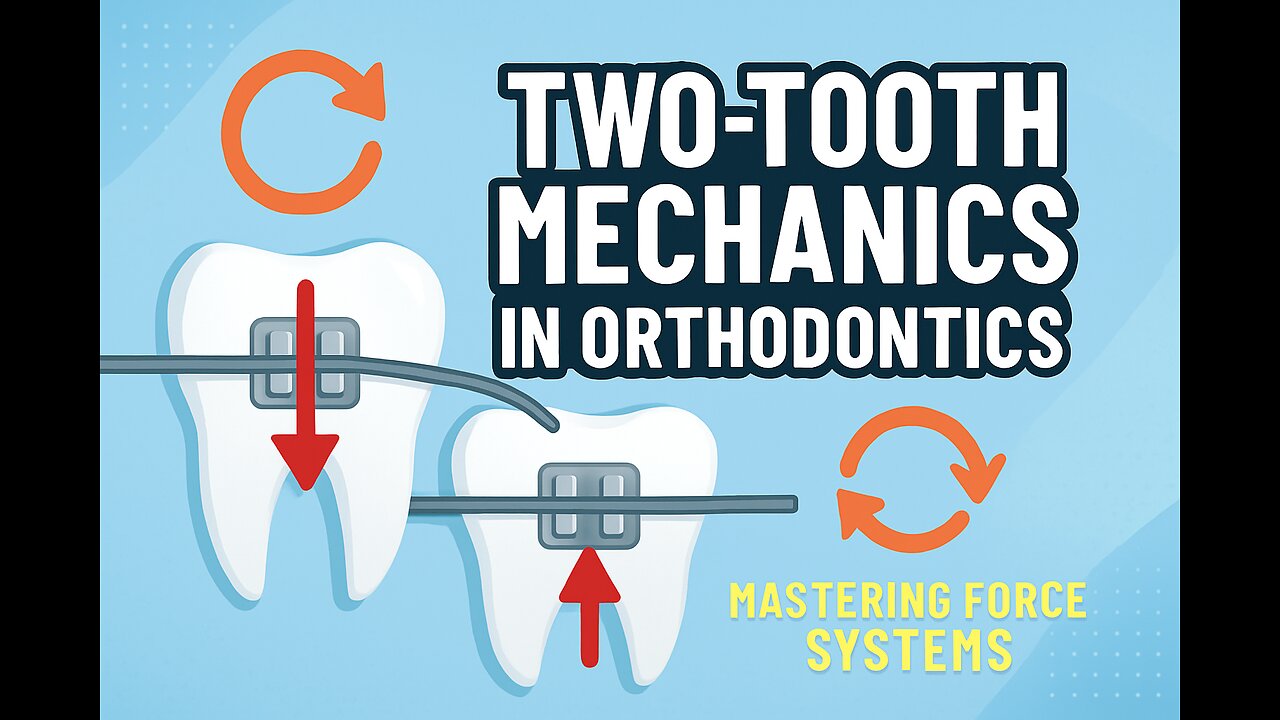Premium Only Content

Two-Tooth Mechanics in Orthodontics: Mastering Force Systems & Burstone Geometry Classes
Unlock the secrets of precise orthodontic tooth movement with this comprehensive guide to two-tooth mechanics! Whether you're a dental student, orthodontic resident, or practicing orthodontist, understanding the force systems between just two teeth is fundamental to mastering complex orthodontic treatment.
In this in-depth video, we explore the fascinating world of statically determinate force systems, where orthodontists can actually predict the final positions of teeth by analyzing the forces and moments acting on them. We'll break down real-world examples, including how different anchorage values between teeth (like a canine vs. premolar vs. molar) dramatically affect treatment outcomes.
Discover the groundbreaking Burstone Geometry Classes – six fundamental categories that help orthodontists understand the complex interactions between wires and brackets. From Class I geometry with equal bracket angulations to the perfectly balanced Class VI geometry with equal and opposite moments, you'll learn how each configuration creates unique force systems and tooth movements.
We'll also dive deep into the practical applications of V-bend arches and stepped-arch mechanics, showing you how the position of bends in orthodontic wires can completely change the force system. Learn about gable bends, artistic bends, and how utility arches work to create precise, controlled tooth movement.
Key Topics Covered:
•
Statically Determinate Force Systems in Orthodontics
•
Predicting Tooth Movement with Force Analysis
•
Anchorage Values and Their Clinical Impact
•
Burstone Geometry Classes (I through VI)
•
Wire-Bracket Angulations and Moment Calculations
•
V-Bend Arch Mechanics and Applications
•
Gable Bends and Root Uprighting
•
Stepped-Arch Mechanics and Force Distribution
•
Artistic Bends for Incisor Correction
•
Clinical Applications and Treatment Planning
Who is this video for?
•
Dental Students studying orthodontics
•
Orthodontic Residents
•
Practicing Orthodontists seeking to refine their mechanics
•
Dental Faculty teaching biomechanics
•
Anyone interested in the engineering behind tooth movement
This video transforms complex biomechanical principles into clear, visual explanations that will enhance your understanding of orthodontic force systems. By the end, you'll have the knowledge to analyze, predict, and control tooth movement with greater precision and confidence.
Don't forget to LIKE, SHARE, and SUBSCRIBE for more advanced orthodontic content that makes complex concepts accessible!
-
 LIVE
LIVE
The Big Mig™
2 hours agoTrump, Chuck Schumer & Hakeem Jeffries Can Go Pound Sand!
6,000 watching -
 1:09:27
1:09:27
The Kevin Trudeau Show Limitless
1 hour agoHow Energy, Mindset, And Marketing Really Work: Kevin Trudeau Reveals All!
221 -
 1:35:46
1:35:46
Dear America
2 hours agoGoogle ADMITS CENSORING Under Biden!! WE WERE RIGHT!! + The UN Sabotaged Trump!!
99.4K57 -
 LIVE
LIVE
Badlands Media
8 hours agoBadlands Daily: September 24, 2025
3,417 watching -
 2:15:08
2:15:08
Matt Kohrs
11 hours agoMarket Open: Bounce or Breakdown? LIVE Trading & Breaking News
14.9K1 -
 LIVE
LIVE
Wendy Bell Radio
6 hours agoThe Left Lies About Everything
6,987 watching -
 1:59:31
1:59:31
FusedAegisTV
10 hours agoTGS 2025 Capcom Online Special Program REACTION 9.24.2025 | FusedAegis Presents
2.83K -
 1:12:16
1:12:16
WickedVirtue
4 hours agoCharlie Kirk's Influence -Wicked Wednesday 9/24
2.3K2 -
 19:41
19:41
Clownfish TV
5 hours agoJimmy Kimmel Still NOT Airing on Nexstar or Sinclair Stations! | Clownfish TV
5.64K16 -
 1:06:56
1:06:56
Crypto Power Hour
2 hours ago $0.56 earnedYour Crypto Guide To Decoding The Lingo
15.6K2